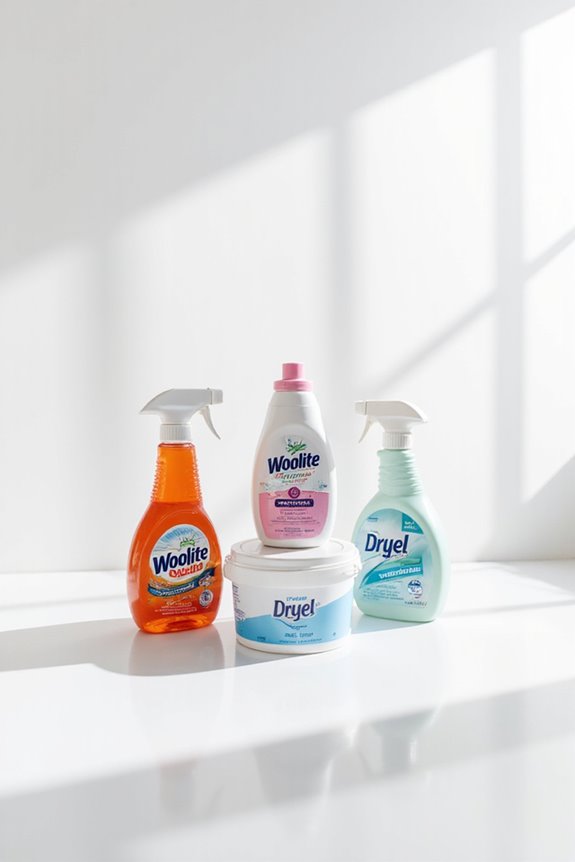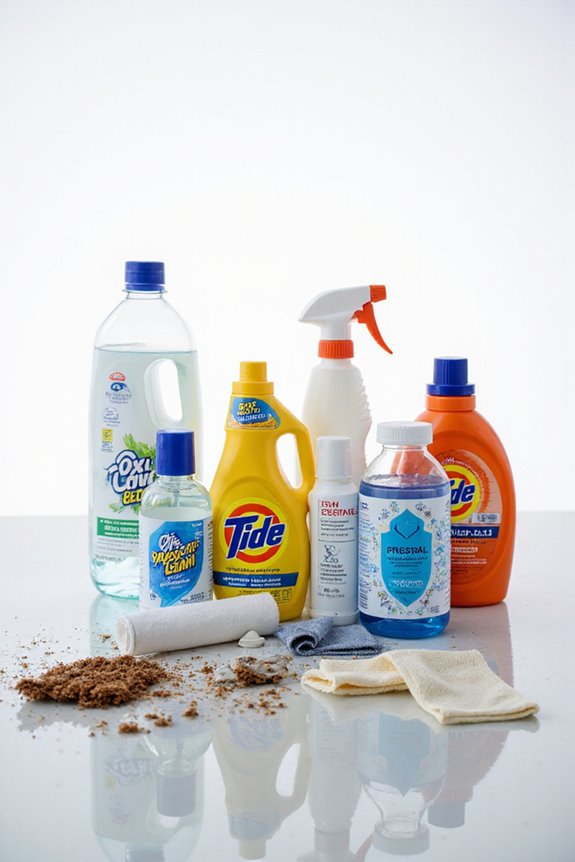When we tackle stains on polyester, it’s best to first identify the stain type—oil or protein-based. For oil stains, a dab of dish soap works wonders, while enzyme-based removers are great for protein stains. Let’s not rub the stain in; instead, we gently blot it away. After applying the remover, wait about 15 to 20 minutes before rinsing with cold water. And remember, patience pays off—stick around, and we’ll share more handy tips!
Key Takeaways
- Identify the stain type and conduct a fabric sensitivity test on a hidden area before applying any stain remover.
- Gently dab excess liquid from the stain, avoiding rubbing to prevent deeper penetration into the fibers.
- Apply an enzyme-based stain remover directly on the stain, working from the outer edges towards the center.
- Allow the remover to sit for 15 to 20 minutes, then rinse the fabric with cold water to remove the solution.
- Inspect the fabric for any lingering stains before drying; repeat treatment if necessary to avoid setting the stain.
Preparing Polyester for Stain Removal
When we’re getting ready to tackle a stain on polyester, it’s important to start with a few key steps. First, let’s use some stain identification techniques to figure out what we’re dealing with. Is it oil-based or protein-based? Knowing this helps us choose the right approach. Next, we need a fabric sensitivity analysis. We should always test any cleaning solution on a hidden area of the fabric. This guarantees we don’t accidentally ruin our favorite shirt! Additionally, selecting an enzyme-based remover can enhance the effectiveness of the stain removal process.
Once we’ve assessed the stain and fabric, we can gently dab away any excess liquid. Remember, we should avoid rubbing it in. Turning the garment inside out helps protect it during washing. By following these steps, we’re setting ourselves up for success in stain removal!
Common Stain Types and Treatment Methods
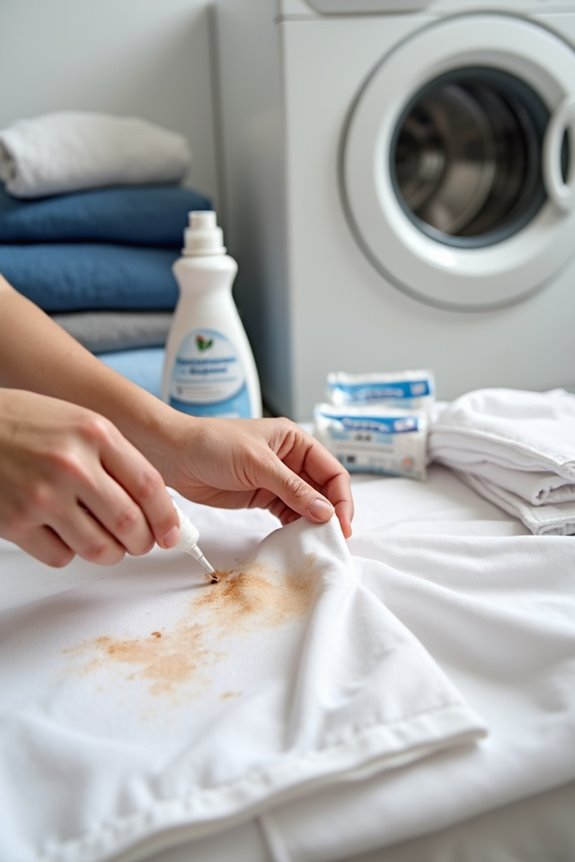
Stains on polyester can seem like a nightmare, especially if we don’t know what we’re dealing with. Oil stains from cooking oils or makeup cling stubbornly to the fabric. It’s best to pre-treat these with dish soap or a degreaser before washing. Remember, cold water is our friend here; we want to avoid heat that could set the stain.
Now, let’s talk about sugar stains from fruit juice or sodas. These can crystallize and become tough to remove if left too long. So, we should act quickly! Soaking in cold water helps dissolve the sugar, and enzyme detergents work wonders for breaking down residues. With a little patience, we can tackle these stains together! Additionally, using a detergent with powerful natural enzymes can enhance stain removal effectiveness.
Effective Use of Alcohol-Based Stain Removers
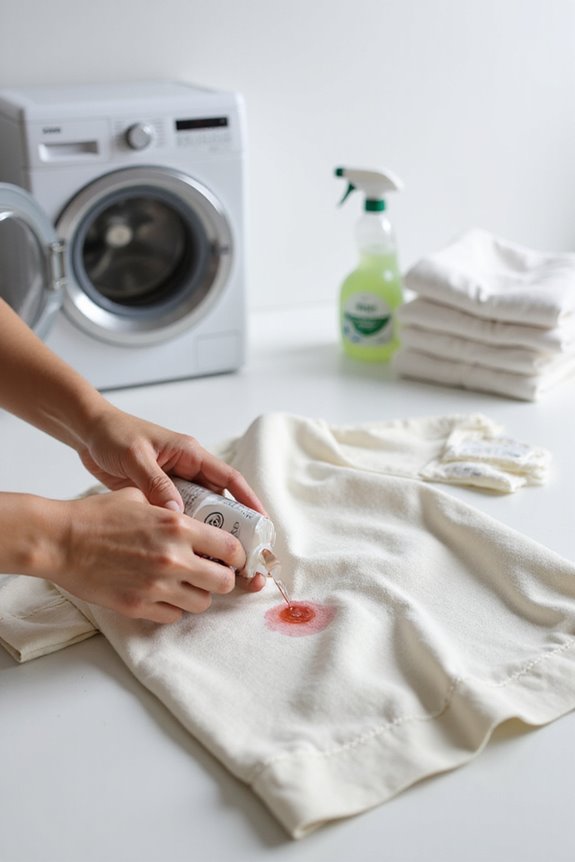
Using alcohol-based stain removers can be a game changer for tackling tough stains on polyester. We typically find that a solution with 70% isopropyl alcohol strikes the right balance between effectiveness and safety for our fabrics. This concentration is great for breaking down oily and ink-based stains, especially if we act quickly before the stain’s longevity sets in. Alcohol penetrates the polyester fibers without causing damage, unlike harsher chemicals. Plus, mixing it with white vinegar can boost performance on stubborn ink stains. Just remember to test it on a hidden part of the fabric first, so we don’t accidentally ruin our favorite shirt. It’s all about being careful while getting rid of those pesky stains!
Application Techniques for Optimal Results
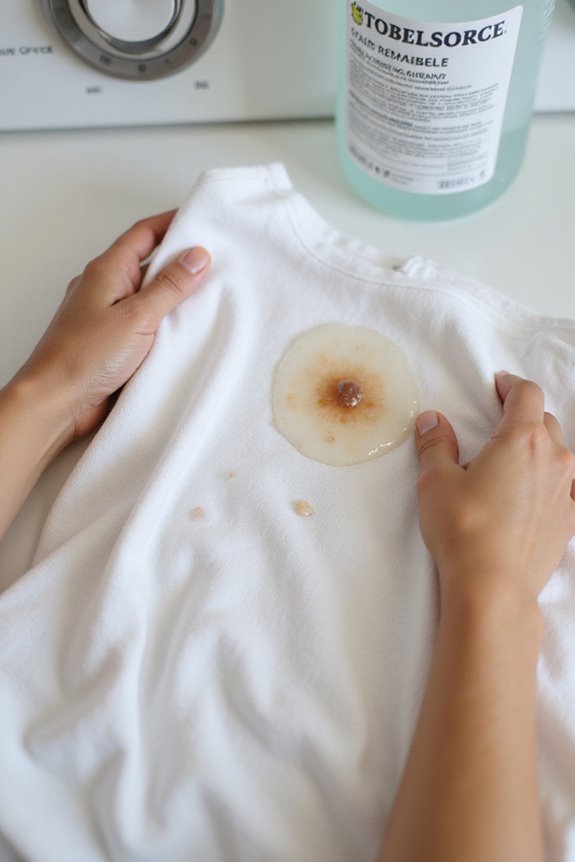
To get the best results with stain removers on polyester, it is essential to follow some tried-and-true techniques. First, we should always start with immediate blotting techniques. Using an absorbent cloth or blotting paper prevents stains from spreading. Remember, rubbing can push the stain deeper, so let’s avoid that.
When applying stain removers, we can enhance enzyme effectiveness by using enzyme-based products. A little dab goes a long way! Apply the remover gently, working from the outer edges towards the center. After letting it sit for 15 to 20 minutes, rinse with cold water. For tough stains, multiple applications can work wonders. Enzyme-based formulas are particularly effective for breaking down blood proteins, making them ideal for blood stains. Let’s keep it simple and effective, and we’ll tackle those pesky stains together!
Post-Treatment Care and Stain Management Tips
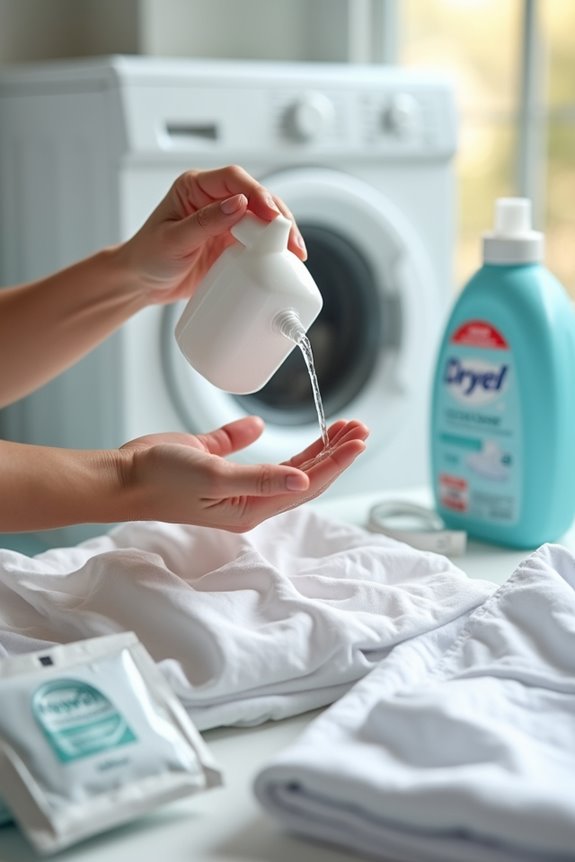
After we’ve tackled those pesky stains on our polyester, it’s essential to give our garments some extra love and care. First up, let’s make sure we do a post-treatment inspection. If we spot any lingering stains, we should repeat our stain removal steps before tossing them in the dryer. Remember, heat can set stains! For preventative maintenance, we can keep a stain removal kit handy with gentle agents like white vinegar and baking soda. It’s smart to handle those sensitive spots like cuffs carefully, treating them regularly. Plus, let’s avoid direct sunlight on stained fabrics—no one likes a faded shirt! By adopting these practices, we can keep our polyester looking fresh and fabulous for longer. Additionally, using eco-friendly options can help ensure that our stain removal process is not only effective but also safe for the environment.
Frequently Asked Questions
Can I Use a Washing Machine for Stained Polyester?
Yes, we can use a washing machine for stained polyester! We should adjust washing settings based on stain types, using gentle cycles and cool water to protect the fabric while effectively tackling those pesky stains.
How Do I Store Polyester Garments to Prevent Stains?
Storing polyester garments is like tucking treasures away; we should use proper storing techniques to guarantee stain prevention. Let’s clean, dry, and store them carefully to keep our clothes looking fresh and vibrant.
Are There Any Home Remedies for Polyester Stain Removal?
When it comes to home remedies for polyester stain removal, we can use a baking soda paste or a vinegar solution. Both methods gently lift stains without damaging the fabric, making them effective options for us.
What Should I Do if the Stain Worsens After Treatment?
If our stain treatment worsens, let’s stop applying products immediately. We should gently blot, rinse with cold water, and air dry. For future stains, effective stain prevention is key to avoiding similar issues.
Can I Use Fabric Softeners on Polyester After Stain Removal?
While we might love the softness fabric softeners provide, they can harm our polyester garments. Instead, let’s explore fabric softener alternatives for ideal polyester care, ensuring our clothes stay vibrant and functional for longer.




